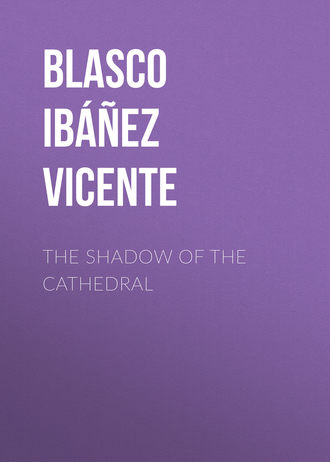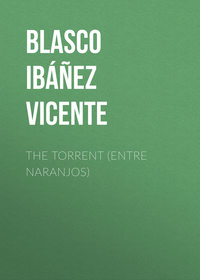 полная версия
полная версияThe Shadow of the Cathedral

Vicente Blasco Ibáñez
The Shadow of the Cathedral
INTRODUCTION
There are three cathedrals which I think will remain chief of the Spanish cathedrals in the remembrance of the traveller, namely the Cathedral at Burgos, the Cathedral at Toledo, and the Cathedral at Seville; and first of these for reasons hitherto of history and art, and now of fiction, will be the Cathedral at Toledo, which the most commanding talent among the contemporary Spanish novelists has made the protagonist of the romance following. I do not mean that Vincent Blasco Ibañez is greater than Perez Galdós, or Armando Palacio Valdés or even the Countess Pardo-Bazan; but he belongs to their realistic order of imagination, and he is easily the first of living European novelists outside of Spain, with the advantage of superior youth, freshness of invention and force of characterization. The Russians have ceased to be actively the masters, and there is no Frenchman, Englishman, or Scandinavian who counts with Ibañez, and of course no Italian, American, and, unspeakably, no German.
I scarcely know whether to speak first of this book or the writer of it, but as I know less of him than of it I may more quickly dispatch that part of my introduction. He was born at Valencia in 1866, of Arragonese origin, and of a strictly middle class family. His father kept a shop, a dry-goods store in fact, but Ibañez, after fit preparation, studied law in the University of Valencia and was duly graduated in that science. Apparently he never practiced his profession, but became a journalist almost immediately. He was instinctively a revolutionist, and was imprisoned in Barcelona, the home of revolution, for some political offence, when he was eighteen. It does not appear whether he committed his popular offence in the Republican newspaper which he established in Valencia; but it is certain that he was elected a Republican deputy to the Cortes, where he became a leader of his party, while yet evidently of no great maturity.
He began almost as soon to write fiction of the naturalistic type, and of a Zolaistic coloring which his Spanish critics find rather stronger than I have myself seen it. Every young writer forms himself upon some older writer; nobody begins master; but Ibañez became master while he was yet no doubt practicing a prentice hand; yet I do not feel very strongly the Zolaistic influence in his first novel, La Barraca, or The Cabin, which paints peasant life in the region of Valencia, studied at first hand and probably from personal knowledge. It is not a very spacious scheme, but in its narrow field it is strictly a novela de costumbres, or novel of manners, as we used to call the kind. Ibañez has in fact never written anything but novels of manners, and La Barraca pictures a neighborhood where a stranger takes up a waste tract of land and tries to make a home for himself and family. This makes enemies of all his neighbors who after an interval of pity for the newcomer in the loss of one of his children return to their cruelty and render the place impossible to him. It is a tragedy such as naturalism alone can stage and give the effect of life. I have read few things so touching as this tale of commonest experience which seems as true to the suffering and defeat of the newcomers, as to the stupid inhumanity of the neighbors who join, under the lead of the evillest among them, in driving the strangers away; in fact I know nothing parallel to it, certainly nothing in English; perhaps The House with the Green Shutters breathes as great an anguish.
At just what interval or remove the novel which gave Ibañez worldwide reputation followed this little tale, I cannot say, and it is not important that I should try to say. But it is worth while to note here that he never flatters the vices or even the swoier virtues of his countrymen; and it is much to their honor that they have accepted him in the love of his art for the sincerity of his dealing with their conditions. In Sangre y Arena his affair is with the cherished atrocity which keeps the Spaniards in the era of the gladiator shows of Rome. The hero, as the renowned torrero whose career it celebrates, from his first boyish longing to be a bull-fighter, to his death, weakened by years and wounds, in the arena of Madrid, is something absolute in characterization. The whole book in fact is absolute in its fidelity to the general fact it deals with, and the persons of its powerful drama. Each in his or her place is realized with an art which leaves one in no doubt of their lifelikeness, and keeps each as vital as the torrero himself. There is little of the humor which relieves the pathos of Valdés in the equal fidelity of his Marta y Maria or the unsurpassable tragedy of Galdós in his Doña Perfecta. The torrero's family who have dreaded his boyish ambition with the anxiety of good common people, and his devotedly gentle and beautiful wife,—even his bullying and then truckling brother-in-law who is ashamed of his profession and then proud of him when it has filled Spain with his fame,—are made to live in the spacious scene. But above all in her lust for him and her contempt for him the unique figure of Doña Sol astounds. She rules him as her brother the marquis would rule a mistress; even in the abandon of her passion she does not admit him to social equality; she will not let him speak to her in thee and thou, he must address her as ladyship; she is monstrous without ceasing to be a woman of her world, when he dies before her in the arena a broken and vanquished man. The torrero is morally better than the aristocrat and he is none the less human though a mere incident of her wicked life,—her insulted and rejected worshipper, who yet deserves his fate.
Sangre y Arena is a book of unexampled force and in that sort must be reckoned the greatest novel of the author, who has neglected no phase of his varied scene. The torrero's mortal disaster in the arena is no more important than the action behind the scenes where the gored horses have their dangling entrails sewed up by the primitive surgery of the place and are then ridden back into the amphitheatre to suffer a second agony. No color of the dreadful picture is spared; the whole thing passes as in the reader's presence before his sight and his other senses. The book is a masterpiece far in advance of that study of the common life which Ibañez calls La Horda; dealing with the horde of common poor and those accidents of beauty and talent as native to them as to the classes called the better. It has the attraction of the author's frank handling, and the power of the Spanish scene in which the action passes; but it could not hold me to the end.
It is only in his latest book that he transcends the Spanish scene and peoples the wider range from South America to Paris, and from Paris to the invaded provinces of France with characters proper to the times and places. The Four Horsemen of the Apocalypse has not the rough textures and rank dyes of the wholly Spanish stories, but it is the strongest story of the great war known to me, and its loss in the Parisian figures is made more than good in the novelty and veracity of the Argentinos who supply that element of internationality which the North American novelists of a generation ago employed to give a fresh interest to their work. With the coming of the hero to study art and make love in the conventional Paris, and the repatriation of his father, a cattle millionaire of French birth from the pampas, with his wife and daughters, Ibañez achieves effects beyond the art of Henry James, below whom he nevertheless falls so far in subtlety and beauty.
The book has moments of the pathos so rich in the work of Galdós and Valdés, and especially of Emilia Pardo-Bazan in her Morriña or Home Sickness, the story of a peasant girl in Barcelona, but the grief of the Argentine family for the death of the son and brother in battle with the Germans, has the appeal of anguish beyond any moment in La Catedral. I do not know just the order of this last-mentioned novel among the stories of Ibañez, but it has a quality of imagination, of poetic feeling which surpasses the invention of any other that I have read, and makes me think it came before Sangre y Arena, and possibly before La Horda. I cannot recall any other novel of the author which is quite so psychological as this. It is in fact a sort of biography, a personal study, of the mighty fane at Toledo, as if the edifice were of human quality and could have its life expressed in human terms. There is nothing forced in the poetic conception, or mechanical in the execution. The Cathedral is not only a single life, it is a neighborhood, a city, a world in itself; and its complex character appears in the nature of the different souls which collectively animate it. The first of these is the sick and beaten native of it who comes back to the world which he has never loved or trusted, but in which he was born and reared. As a son of its faith, Gabriel Luna was to have been a priest; but before he became a minister of its faith, it meant almost the same that he should become a Carlist soldier, and fight on for that cause till it was hopeless. In his French captivity he loses the faith which was one with the Carlist cause, and in England he reads Darwin and becomes an evolutionist of the ardor which the evolutionists have now lost. He wanders over Europe with the English girl whom he worships with an intellectual rather than passionate ardor, and after her death he ends at Barcelona in time to share one of the habitual revolutions of the province and to spend several years in one of its prisons. When he comes out it is into a world which he is doomed to leave; he is sick to death and in hopeless poverty; he has lost the courage of his revolutionary faith if not his fealty to it; all that he asks of the world is leave to creep out of it and somewhere die in peace. He thinks of an elder brother who like himself was born in the precincts of the Cathedral where generations of their family have lived and died, and his brother does not deny him. In fact the kind, dull gardener welcomes him to a share of his poverty, and Gabriel begins dying where he began living. The kindness between the brothers is as simple in the broken adventurer whose wide world has failed him as in the aging peasant, pent from his birth in the Cathedral close, with no knowledge of anything beyond it. All their kindred who serve in their several sort the stepmother church, down to the gardener's son whose office is to keep dogs out of the Cathedral and has the title of perrero, are good to the returning exile. They do not well understand what and where he has been; the tradition of his gifted youth when he was dedicated to the church and forsook her service at the altar for her service in the field, remains unquestioned, and he is safe in the refuge of his family who can offer mainly their insignificance for his protection. The logic of the fact is perfect, and Gabriel's emergence from the quiet of his retreat inevitably follows from the nature of the agitator as the logic of his own past and has the approval at least of the perrero and the allegiance of the rest. What is very important in the affair is that most of the inhabitants of this Cathedral-world, rich and poor, good, bad, and indifferent, mean and generous, are few of them wicked people, as wickedness is commonly understood; they all have their habitual or their occasional moments of good will.
The refugee is tired of his past but he does not deny his faith in humanity; his doctrine only postpones to a time secularly remote the redemption of humanity from its secular suffering. He begins at once to do good; he rescues his kind elder brother from the repudiation of the daughter whom he has cast off because her seduction has condemned her to a life of shame; he wins back the poor prostitute to her home, and forces her father to tolerate her in it.
Most of the Cathedral folk are of course miserably poor, but willing to be better than they are if they can keep from starving; the fierce and prepotent Cardinal who is over them all, has moments of the common good will, when he forgives all his enemies except the recalcitrant canons. He likes to escape from these, and talk with the elderly widow of the gardener whom he has known from his boyhood, and to pity himself in her presence and smoke himself free from, his rancor and trouble. He is such a prelate as we know historically in enough instances; but he is pathetic in that simplicity which survives in him and almost makes good the loss of innocence in Latin souls. He keeps with him the young girl who is the daughter of his youth, and whom it cuts him to the soul to have those opprobrious canons imagine his mistress. He is one out of the many figures that affirm their veracity in the strange world where they have their being; and he is only the more vivid as the head of a hierarchy which he rules rather violently though never ignobly.
But the populace, the underpaid domestics and laborers of the strange ecclesiastical world in their wretched over-worked lives and hopeless deaths are what the author presents most vividly. There is the death of the cobbler's baby which starves at the starving mother's breast which the author makes us witness in its insupportable pathos, but his art is not chiefly shown in such extremes: his affair includes the whole tragical drama of the place, both its beauty and its squalor of fact, but he keeps central the character of the refugee, Gabriel Luna, in the allegiance to his past which he cannot throw off. When he begins to teach the simple denizens of the Cathedral, some of them hear him gladly, and some indifferently, and some unwillingly, but none intelligently. He fails with them in that doctrine of patience which was his failure, as an agitator, with the proletariat wherever he has been; they could not wait through geological epochs for the reign of mercy and justice which he could not reasonably promise the over-worked and underfed multitude to-morrow or the day after. His brother, who could not accept his teachings, warns him that the people of the Cathedral will not understand him and cannot accept his scientific gospel, and for a while he desists. In fact he takes service in the ceremonial of the Cathedral; he even plays a mechanical part in the procession of Corpus Christi, and finally he becomes one of the night-watchmen who guard the temple from the burglaries always threatening its treasures.
The story is quite without the love-interest which is the prime attraction of our mostly silly fiction. Gabriel's association with the English girl who wanders over Europe with him is scarcely passionate if it is not altogether platonic; his affection for the poor girl for whom he has won her father's tolerance if not forgiveness becomes a tender affection, but not possibly more; and there is as little dramatic incident as love interest in the book. The extraordinary power of it lies in its fealty to the truth and its insight into human nature. The reader of course perceives that it is intensely anti-ecclesiastical, but he could make no greater mistake than to imagine it in any wise Protestant. The author shares this hate or slight of ecclesiasticism with all the Spanish novelists, so far as I know them; most notably with Perez Galdós in Doña Perfecta and Lean Rich, with Pardo-Bazan in several of her stories, with Palacio Valdés in the less measure of Marta y Maria, and La Hermana de San Sulpicio and even with the romanticist Valera in Pepita Jimenez. But it may be said that while Ibañez does not go any farther than Galdós, for instance, he is yet more intensively agnostic. He is the standard bearer of the scientific revolt in the terms of fiction which spares us no hope of relief in the religious notion of human life here or hereafter that the Hebraic or Christian theology has divined.
It is right to say this plainly, but the reader who can suffer it from the author will find his book one of the fullest and richest in modern fiction, worthy to rank with the greatest Russian work and beyond anything yet done in English. It has not the topographical range of Tolstoy's War and Peace, or Resurrection; but in its climax it is as logically and ruthlessly tragical as anything that the Spanish spirit has yet imagined.
Whoever can hold on to the end of it will find his reward in the full enjoyment of that "noble terror" which high tragedy alone can give. Nothing that happens in the solemn story—in which something significant is almost always happening—is of the supreme effect of the socialist agitator's death at the hands of the disciples whom he has taught to expect mercy and justice on earth, but forbidden to expect it within the reach of the longest life of any man or race of men. His rebellious followers come at night into the Cathedral where Gabriel is watching, to rob an especially rich Madonna, whom he has taught them to regard as a senseless and wasteful idol, and they will not hear him when he pleads with them against the theft. The inevitable irony of the event is awful, but it is not cruel, rather it is the supreme touch of that pathos which seems the crowning motive of the book.
W.D. HOWELLS.* * * * *THE SHADOW OF THE CATHEDRAL
CHAPTER I
The dawn was just rising when Gabriel Luna arrived in front of the Cathedral, but in the narrow street of Toledo it was still night. The silvery morning light that had scarcely begun to touch the eaves and roofs, spread out more freely in the little Piazza del Ayuntamiento, bringing out of the shadows the ugly front of the Archbishop's Palace, and the towers of the municipal buildings capped with black slate, a sombre erection of the time of Charles V.
Gabriel walked for some time up and down the deserted square, wrapping himself up to his eyes in the muffler of his cloak, while at intervals his hollow cough shook him painfully. Without daring to stop walking on account of the bitter cold, he looked at the great doorway called "del Perdon," the only part of the church able to present a really imposing aspect. He recalled other famous cathedrals, isolated, occupying commanding situations, showing themselves freely in the full pride of their beauty, and he compared them with this Cathedral of Toledo, the mother-church of Spain, smothered by the swarm of poverty-stricken buildings that surrounded it, clinging closely to its walls, permitting it to display none of its exterior beauties, beyond what could be seen from the narrow streets that closed it in on every side. Gabriel, who was acquainted with its interior magnificence, thought of the deceptive oriental houses, outwardly squalid and miserable, but inwardly rich in alabasters and traceries. Jews and Moors had not lived in Toledo for centuries in vain, their aversion to outward show seemed to have influenced the building of the Cathedral, now suffocated by the miserable hovels, pushed and piled up against it, as though seeking its protection.
The little Piazza del Ayuntamiento was the only open space that allowed the Christian monument to display any of its grandeur; under this little patch of open sky the early morning light showed the three immense Gothic arches of its principal front, the hugely massive bell tower, with its salient angles, ornamented by the cap of the Alcuzon, a sort of black tiara, with three crowns, almost lost in the grey mist of the wintry dawn.
Gabriel looked affectionately at the closed and silent fane, where his family lived, and where he himself had spent the happiest days of his life. How many years had passed since he had last seen it! And now he waited anxiously for the opening of its doorways.
He had arrived in Toledo by train the previous night from Madrid. Before shutting himself up in his miserable little room in the Posada del Sangre (the ancient Messon del Sevillano, inhabited by Cervantes) he had felt a feverish desire to revisit the Cathedral, and had spent nearly an hour walking round it, listening to the barking of the Cathedral watch-dog, who growled suspiciously, hearing the sound of footsteps in the surrounding streets. He had been unable to sleep; the fact of returning to his native town after so many years of misery and adventures had taken from him all desire to rest, and, while it was still night, he again stole out to await near the Cathedral the moment that it should be opened.
To while away the time he paced up and down the front, admiring again the beauties of the porch, and noting its defects aloud, as though he wished to call the stone benches of the Piazza and its wretched little trees as witnesses to his criticisms.
An iron grating surmounted by urns of the seventeenth century ran in front of the porch, enclosing a wide, flagged space, where in former times the sumptuous processions of the Chapter had assembled, and where the multitude could admire the grotesque giants on high days and festivals.
The first storey of the façade was broken in the centre by the great Puerta del Perdon, an enormous and very deeply-recessed Gothic arch, which narrowed as it receded by the gradations of its mouldings, adorned by statues of apostles, under open-worked canopies, and by shields emblazoned with lions and castles. On the pillar dividing the doorway stood Jesus in kingly crown and mantle, thin and drawn out, with the look of emaciation and misery that the imagination of the Middle Ages conceived necessary for the expression of Divine sublimity. In the tympanum a relievo represented the Virgin surrounded by angels, robed in the habit of St. Ildefonso, a pious legend repeated in various parts of the building as though it were one of its chief glories.
On one side was the doorway called "de la Torre,"1 on the other side that called "de los Escribanos,"2 for by it entered in former days the guardians of public religion to take the oath to fulfil the duties of their office. Both were enriched with stone statues on the jambs, and by wreaths of little figures, foliage, and emblems that unrolled themselves among the mouldings till they met at the summit of the arch.
Above these three doorways with their exuberant Gothic rose the second storey of Greco-Romano and almost modern construction, causing Gabriel the same annoyance as would a discordant trumpet interrupting a symphony. Jesus and the twelve apostles, all life size, seated at the table, each under his own canopied niche, could be seen above the central porch, shut in by the two tower-like buttresses which divided the front into three parts. Beyond, two rows of arcades of inferior design, belonging to the Italian palace, extended as far as those under which Gabriel had so often played as a child when living in the house of the bell-ringer.
The riches of the Church, thought Luna, were a misfortune for art; in a poorer church the uniformity of the ancient front would have been preserved. But, then, the Archbishop of Toledo had eleven millions of yearly revenue, and the Chapter as many more; they did not know what to do with their money, so started works and made reconstructions, and the decadent art produced monstrosities like that one of the Last Supper.
Above, again, rose the third storey, two great arches that lighted the large rose of the central nave. The whole was crowned by a balustrade of open-worked stone following the sinuosities of the frontage, between the two salient masses that guarded it, the tower and the Musarabé chapel.
Gabriel ceased his contemplation, seeing that he was no longer alone in front of the church. It was nearly daylight, and several women with bowed heads, their mantillas falling over their eyes, were passing in front of the iron grating. The crutches of a lame man rang out on the fine tiles of the pavement, and, out beyond the tower, under the great arch of communication between the archbishop's palace and the Cathedral, the beggars were gathering in order to take up their accustomed positions at the cloister door. The faithful and "God's creatures"3 knew one another; every morning they were the first occupants of the church, and this daily meeting had established a kind of fraternity, and with much coughing and hoarseness they all lamented the cold of the morning and the lateness of the bell-ringer in coming down to open the doors.









